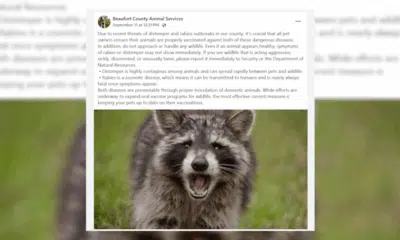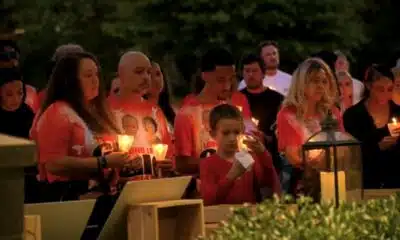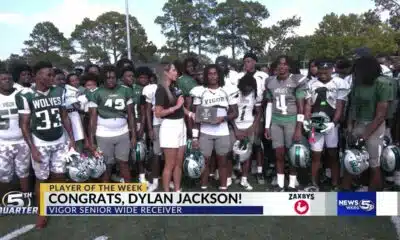News from the South - North Carolina News Feed
Two sought refuge together, but Swannanoa River’s flooding proved fatal • Asheville Watchdog
Asheville Watchdog is bringing you the stories behind the staggering loss of life from Helene, the children, parents, grandparents, multiple generations of a single family, all gone in one of the worst natural disasters to hit the mountains of western North Carolina. This is the third installment.
Zubila Shafiq saw her husband, Omar Khan, for the last time on the night of Sept. 26.
Khan was in his van near the Swannanoa River on River’s Edge Road in the Azalea neighborhood when Shafiq and their two young boys, Zach, 9, and Zayn, 7, talked to him on FaceTime. Shafiq invited him to her place – they were separated – but he declined. Instead, he parked his van higher up a hill. Then they hung up.
“That was the last I saw him,” Shafiq said. “On FaceTime. And he was actually still in his car.”
What happened after their call became clear over the ensuing days, after the floodwaters subsided and the debris settled, allowing Shafiq to go on a regionwide search for Khan, one that ultimately led her to his neighbors and a grim story of what were likely his last moments.
Installment 1: Helene took entire families, couples, children
Installment 2: Fairview landslides from Helene that killed 13 were among worst in North Carolina history
Khan, 44, returned to his residence at the Riverview Apartments on River’s Edge Road east of Asheville after the FaceTime call. Neighbors told Shafiq he had not evacuated.
A little before 11 a.m. on Sept. 27, neighbors threw Khan ropes in the hopes of rescuing him. A “civilian rescue,” Shafiq called the vain attempt to assist him in a Facebook post after the storm.
“I tried to save him,” one of Khan’s neighbors told her.
The neighbor told Shafiq that they had talked to Khan that morning as he and Samira Zoobi, a fellow resident of the apartment complex, were perched on a balcony above the water.
“Thank you,” Khan responded, according to the neighbor. “God bless you!”
Then the apartment broke away and spun down the bloated, raging Swannanoa.
Neighbors called 911. Rescue workers arrived in about an hour, Shafiq said, but it was too late. By the neighbor’s account, the building had come off its foundation — which, according to photos, was metal stilts — flipped on its side, drifted away and became lodged on a riverbank.

The neighbor threw rocks at the building to see if someone would respond. Search and rescue workers went in, but found no one.
Days later, Shafiq tried to get to Khan’s apartment. That proved impossible, but she came close enough for one of her sons to spot something amid the debris.
“That looks like our van,” he told her.
Someone working on the rescue and recovery efforts in the area asked Shafiq, “Do you want me to go check and see? What’s your license plate?”
He walked down the road and returned.
A punch in the gut
“It was our van, and it was completely demolished,” Shafiq said. “It just, like, punched me in the gut, because I was like, ‘That’s the van. That was supposed to be safe.’”
Khan was not in it.
Shafiq and others called and visited organizations everywhere: the VA hospital, the A-B Tech medical shelter, the Ag Center emergency shelter. No Khan.
Strangely, during Shafiq’s search, Khan’s texts started coming through days after they were sent as she got close to spots of cell service. He had used fellow tenant Zoobi’s phone to try to reach her.

“‘My unit’s submerged. I’m at the top floor with another tenant. I’m okay. I don’t have my phone,’” Shafiq said, summarizing her husband’s texts. He lived on the second floor of the apartment building and had gone up to the third floor with Zoobi.
“Hoping that the search and rescue efforts are continuing, especially in the Azalea area near [John B. Lewis Soccer Fields] and [the Blue Ridge] Parkway bridge,” she posted on Facebook on Oct. 2. “Please continue to be on the lookout and contact me or anyone close to me with any information.”
Shafiq wrote in the post that people looking for Khan were keeping track of recovery efforts and making calls to more than 20 organizations.
“We just need to know where Daddy is. Please keep Praying!!!” she wrote Oct. 6.
Two days later, she started her post with “Omar still missing,” but followed it with a painful acknowledgement: “The search efforts are continuing, but FEMA and APD explicitly said it is now “recovery” (of bodies) not rescue at this point,” she wrote. “Had a few difficult conversations today, which took an emotional toll on me. Honestly, it was hard to be hopeful today.”
The Asheville Police Department kept in touch throughout Shafiq’s search, she said.
Finally, on Oct. 9, 13 days after Khan disappeared, she got the call she dreaded.
“Do you have a quiet place?” an APD employee asked her.
“And she said, ‘We found him,’” Shafiq said.
Khan’s body was recovered Oct. 9 on Moffitt Branch Road near Azalea Baptist Church, according to his death certificate.
A cadaver dog had alerted recovery crews of a body late on the 8th, Shafiq said. An officer had stayed with Khan’s body overnight. He was identified Oct. 9 by a license and passport found in his pocket.
‘I don’t know what the days ahead will look like’
“We all know how smart he was, and he put his license and passport in his pockets,” Shafiq posted on Facebook on Oct. 9. “Fingerprints also confirmed. He was found on Moffitt branch road near his apartment/car so I pray he did not suffer. I don’t know what the days ahead will look like and I may not remember any of it.”

Khan “was amazing,” Shafiq told The Watchdog. “Super compassionate, always going above and beyond. Really tried to help people. Was always dependable.”
The family couldn’t have a traditional Muslim burial for Khan but they had a graveside service Oct. 13. About 70 people came, including one person who drove 15 hours.
Khan was a pharmacist at the Westgate Shopping Center CVS. He’d been a pharmacist since 2014, Shafiq said. Well known by patients and the community, he had worked in Brevard and on Patton Avenue and Tunnel Road.
“He was a good person,” Shafiq said. “He had a pure heart and almost like an innocence. I don’t know how to say it, because he was cynical about things, but also, so innocent because he was a good person.”
He volunteered his time with Asheville Buncombe Community Christian Ministry’s pharmacy. He helped out at flu shot clinics. He volunteered at his son’s daycare kitchen.
“If he saw something that he could do and he could help with, he did it,” Shafiq said.
And, to his last days, Shafiq said, Omar was always working on himself.
“He wanted to be dedicated to service,” she said. “And if that was his goal, I think he reached that goal.”
Samira Zoobi
Samira Zoobi, 28, had been standing on a balcony of her apartment building with Omar Khan waiting for a rescue, when the Swannanoa River swept the structure away.
Zoobi’s best friend, Molly Anne Sheehan, collected accounts of what happened to Zoobi from several witnesses and shared them with The Watchdog.

“Sami’s apartment in the RiverView complex, was on the second floor of a four-unit, two-story building that was on stilts by the Swannanoa River,” Sheehan said. “Around 8 a.m., Sami posted a story on Instagram showing the water level from a bedroom window. The water was already completely covering the road that led out of the neighborhood to Tunnel Road.”
The water was all the way up the stilts the apartment rested on, Sheehan said, more than one story tall but not yet flooding the apartments.
That changed over the next couple of hours.
“By 10:30 a.m., the last texts from Sami were received before cell service went out; the water was up to the second floor where Sami was with a neighbor [Khan] waiting to be rescued by boat; the entire bottom apartments were filled with water,” Sheehan said. “This made the building very unstable, and it eventually ripped off the stilts and floated down the road a little. At this point, early afternoon, help was there actively trying to get them all rescued, the team couldn’t get ropes to them before the entire apartment came loose to the water again and swept it, and the people, farther down the road.”
After the displaced building was found the same day, search and rescue crews searched it, but didn’t find Zoobi or Khan.

Zoobi’s body was found two days later, nearly a mile and ½ from the apartment, according to a death certificate. The cause of death was listed as “landslide injuries including drowning.”
Zoobi’s mother, Collete, told The Watchdog she did not want to revisit the story of her daughter’s death. Zoobi’s father, Fadi, did not respond to a request for an interview.
“Fadi and I are grateful for all the support everyone has provided,” Colette Zoobi said in an Oct. 2 Facebook post. “Asheville experienced catastrophic floods this past weekend. Samira J Zoobi was unable to be rescued. Our family is devastated. I miss her so much. I appreciate all the support we have received from our friends, family, Samira’s friends and coworkers.”
Asheville T-Shirt Co., where Zoobi worked as a graphic designer, posted on Facebook about Zoobi’s death Oct. 2:

“Yesterday, we lost a beloved member of our Asheville T-Shirt family. Our hearts are shattered and we are left broken. Samira was all the things you would come to love and adore in a friend. They were the kindest of souls and incredibly talented in their craft. We were blessed to have spent 3.5 years working alongside Samira; the fond and quirky memories of Samira will forever remain in our hearts. …
“Samira, we love you. We’ll miss you. You will always be in our hearts.”
Zoobi studied new media at UNC Asheville and minored in anthropology.
“Sami’s the most creative person I know, even in their saddest times,” Sheehan told The Watchdog. “Sami was not only my decade-long best friend, Sami was my confidant, therapist, best advice giver, voice of reason, my calm, my art pal, creative twin, my hairdresser, dermatologist, nail tech, screen printer, my life coach… so much more. Sami just played so many roles for so many people, so generous and truly caring, Sami did everything they could for their friends, was the best gift giver, and just such a genuine and thoughtful soul.”
Sheehan said the two were best friends for a decade and at one point lived just 15 minutes apart without knowing it.
“It took years and years for us to actually meet in Asheville in 2014, but we were always so close before we knew how actually close we would become,” she said.
Asheville Watchdog is a nonprofit news team producing stories that matter to Asheville and Buncombe County. Andrew R. Jones is a Watchdog investigative reporter. Email arjones@avlwatchdog.org. The Watchdog’s local reporting during this crisis is made possible by donations from the community. To show your support for this vital public service go to avlwatchdog.org/support-our-publication/.
Related
The post Two sought refuge together, but Swannanoa River’s flooding proved fatal • Asheville Watchdog appeared first on avlwatchdog.org
News from the South - North Carolina News Feed
White House officials hold prayer vigil for Charlie Kirk
SUMMARY: Republican lawmakers, conservative leaders, and Trump administration officials held a prayer vigil and memorial at the Kennedy Center honoring slain activist Charlie Kirk, founder of Turning Point USA. Kirk was killed in Utah, where memorials continue at Utah Valley University and Turning Point USA’s headquarters. Police say 22-year-old Tyler Robinson turned himself in but has not confessed or cooperated. Robinson’s roommate, his boyfriend who is transitioning, is cooperating with authorities. Investigators are examining messages Robinson allegedly sent on Discord joking about the shooting. Robinson faces charges including aggravated murder, obstruction of justice, and felony firearm discharge.
White House officials and Republican lawmakers gathered at the Kennedy Center at 6 p.m. to hold a prayer vigil in remembrance of conservative activist Charlie Kirk.
https://abc11.com/us-world/
Download: https://abc11.com/apps/
Like us on Facebook: https://www.facebook.com/ABC11/
Instagram: https://www.instagram.com/abc11_wtvd/
Threads: https://www.threads.net/@abc11_wtvd
TIKTOK: https://www.tiktok.com/@abc11_eyewitnessnews
News from the South - North Carolina News Feed
Family, friends hold candlelight vigil in honor of Giovanni Pelletier
SUMMARY: Family and friends held a candlelight vigil in Apex to honor Giovanni Pelletier, a Fuquay Varina High School graduate whose body was found last month in a Florida retention pond. Giovanni went missing while visiting family, after reportedly acting erratically and leaving his cousins’ car. Loved ones remembered his infectious smile, laughter, and loyal friendship, expressing how deeply he impacted their lives. His mother shared the family’s ongoing grief and search for answers as authorities continue investigating his death. Despite the sadness, the community’s support has provided comfort. A celebration of life mass is planned in Apex to further commemorate Giovanni’s memory.
“It’s good to know how loved someone is in their community.”
More: https://abc11.com/post/giovanni-pelletier-family-friends-hold-candlelight-vigil-honor-wake-teen-found-dead-florida/17811995/
Download: https://abc11.com/apps/
Like us on Facebook: https://www.facebook.com/ABC11/
Instagram: https://www.instagram.com/abc11_wtvd/
Threads: https://www.threads.net/@abc11_wtvd
TIKTOK: https://www.tiktok.com/@abc11_eyewitnessnews
News from the South - North Carolina News Feed
NC Courage wins 2-1 against Angel City FC
SUMMARY: The North Carolina Courage defeated Angel City FC 2-1 in Cary, ending their unbeaten streak. Monaca scored early at the 6th minute, followed by Bull City native Brianna Pinto’s goal at the 18th minute, securing a 2-0 halftime lead. Angel City intensified in the second half, scoring in the 88th minute, but the Courage held firm defensively to claim victory. Pinto expressed pride in the win, emphasizing the team’s unity and playoff ambitions. Nearly 8,000 fans attended. Coverage continues tonight at 11, alongside college football updates, including the Tar Heels vs. Richmond game live from Chapel Hill.
Saturday’s win was crucial for the Courage as the regular season starts to wind down.
https://abc11.com/post/north-carolina-courage-wins-2-1-angel-city-fc/17810234/
Download: https://abc11.com/apps/
Like us on Facebook: https://www.facebook.com/ABC11/
Instagram: https://www.instagram.com/abc11_wtvd/
Threads: https://www.threads.net/@abc11_wtvd
TIKTOK: https://www.tiktok.com/@abc11_eyewitnessnews
-
News from the South - Kentucky News Feed7 days ago
Lexington man accused of carjacking, firing gun during police chase faces federal firearm charge
-
News from the South - Alabama News Feed7 days ago
Zaxby's Player of the Week: Dylan Jackson, Vigor WR
-
News from the South - Arkansas News Feed7 days ago
Arkansas medical marijuana sales on pace for record year
-
News from the South - North Carolina News Feed5 days ago
What we know about Charlie Kirk shooting suspect, how he was caught
-
News from the South - Missouri News Feed7 days ago
Local, statewide officials react to Charlie Kirk death after shooting in Utah
-
Local News7 days ago
US stocks inch to more records as inflation slows and Oracle soars
-
Local News6 days ago
Russian drone incursion in Poland prompts NATO leaders to take stock of bigger threats
-
Local News Video6 days ago
Introducing our WXXV Student Athlete of the Week, St. Patrick’s Parker Talley!















































